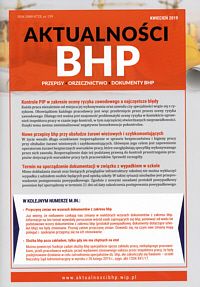
- New safety notes for the operation of tower cranes and quick-assembly cranes (3-5)
On February 16, 2019, the long-awaited regulation on occupational safety and health when operating tower cranes and quick-assembly cranes entered into force. Its main purpose is to provide crane operators with safe working conditions that take into account the specifics of their profession. The Regulation also provides a legal basis for controlling compliance with the provisions on the working conditions of these employees.
- Deadline for preparing documentation in connection with an accident at school (6)
Despite the efforts and ongoing reviews of the school infrastructure, an accident involving people who are in the care of the school can not be excluded. In such a situation it is necessary to conduct post-accident proceedings. According to the new rules, the post-accident report should be prepared within 21 days from the date of termination of the post-accident investigation.
- How to ensure safe loading and unloading of a semi-trailer? (7-8)
Is there a rule or standard prohibiting the unloading of a semi-trailer unfastened from a tractor unit? - There are no regulations prohibiting the unloading of a semi-trailer that is not tilted to a tractor unit.
- Can a teleworker refuse permission to perform health and safety inspections (8)
Where it is possible to send work results electronically, and the work does not require co-operative activities and ongoing supervision by the employer, there is a basis for entrusting work in the form of telework. Although it is usually carried out in the telecommuter's home, it can not be carried out under any conditions. The employer's role is not only to provide the telecommuter with proper equipment, but also to carry out the monitoring of teleworking in terms of health and safety. Can an employee disagree with such control?
- Topic of the issue: Inspections of the National Labor Inspectorate in the area of occupational risk assessment and the most common errors (9-13)
Every work, regardless of the place where it is performed, as well as profession or specialty, is associated with risk. It is the duty of every employer to get through the process of occupational risk assessment. Therefore, it is important to know the issues of risk assessment in the context of the work inspector's powers during the inspections, including the most frequently found irregularities. Thanks to this, negative post-control consequences can be minimized.
- Removal of negligence in the field of occupational safety and health immediately before the inspection protects against punishment (13)
Question: Whether and what sanctions may be with late medical examinations of employees, OSH trainings, machine and equipment inspections, etc. if these negligences are historical (a year ago, a few years) and all irregularities have been removed before the National Labor and State Inspectorate Sanitary Inspection?
- Can periodic tests be carried out during a holiday leave (14-15)
Periodic and follow-up medical examinations shall be carried out, if possible, within the working hours. In practice, however, it can not be ruled out that the period of periodic examinations will fall during the employee's leave. In such a case, will the employee be obliged to carry out tests during the holidays and will the medical certificate issued in such conditions be binding?
- How to organize pedestrian and machine traffic on the internal road? (15-16)
Question: Is the separation of pedestrian and transport roads mandatory?
- What arrangements should be included in the information on how to use the university premises safely and hygienically? (16)
Question: What should contain information on how to use the university premises and technical equipment safely and hygienically and how to proceed in case of accident or breakdown according to the new regulation on how to ensure safe and hygienic working and education conditions at the university?
- Hand signals - exercises (17-18)
In the event of a communication device failure, the signalman and operator (eg a crane) must communicate with each other in some way. They do it with the help of hand signals. for this it is their duty to know and understand manual signals.
- Instruction od occupational safety and health (19-20)
Aktualności BHP (OSH News) - full list







